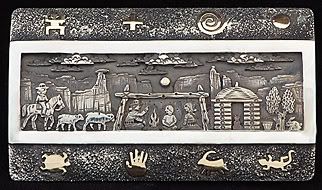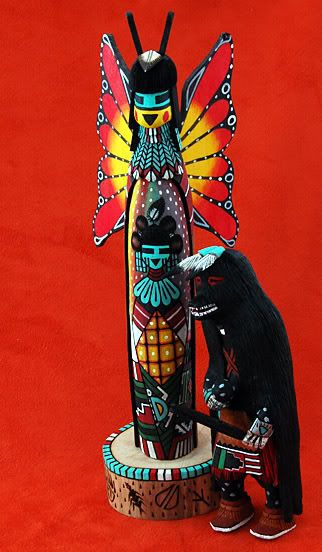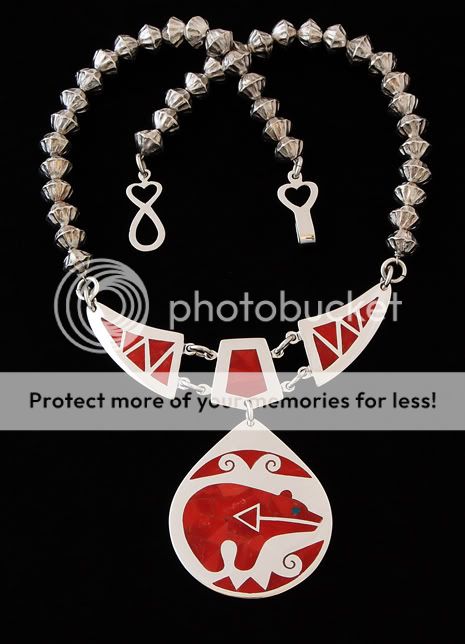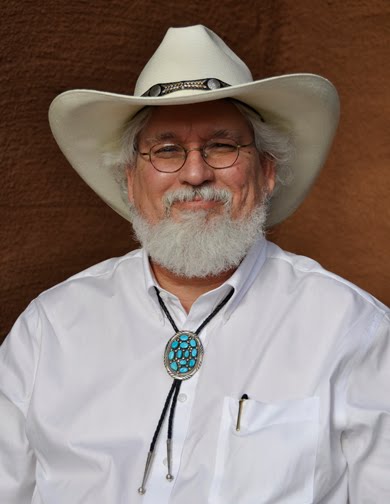
Monday, August 17, 2009
Natay Carroll

Sunday, July 12, 2009
Ray Roanhorse - Nickel Silver Artisan
 Early on Saturday morning a few weeks ago Sandy and I stopped for breakfast at one of Gallup's McDonalds. As we ate we noted a tall Navajo man going table to table offering bowguards (also known as Ketohs) for sale. Bowguards are an ancient leather-based invention designed to protect an archer's wrist from string slap. They are also used as a personal adornment and are frequently worn for ceremorial dress. Although everyone else had waved him on, he found a welcome reception at our table. We learned that he was Ray Roanhorse from Klagetho, Arizona who was taught the craft by his sister Flo. We saw that each bowguard was uniquely stamped and accented with a piece of turquoise from the Sleeping Beauty mine in Arizona. I bought all he had for sale at a price considerably more than he asked.
Early on Saturday morning a few weeks ago Sandy and I stopped for breakfast at one of Gallup's McDonalds. As we ate we noted a tall Navajo man going table to table offering bowguards (also known as Ketohs) for sale. Bowguards are an ancient leather-based invention designed to protect an archer's wrist from string slap. They are also used as a personal adornment and are frequently worn for ceremorial dress. Although everyone else had waved him on, he found a welcome reception at our table. We learned that he was Ray Roanhorse from Klagetho, Arizona who was taught the craft by his sister Flo. We saw that each bowguard was uniquely stamped and accented with a piece of turquoise from the Sleeping Beauty mine in Arizona. I bought all he had for sale at a price considerably more than he asked.I have a particular interest in our regional nickel silversmiths. They work with nickel silver because it is much cheaper to buy than sterling, nonetheless the products are just as labor intensive. Unfortunately, there is very little demand for nickel silver jewelry which sells at a fraction of the cost of sterling based creations. Mr. Roanhorse was pleased that we appreciated his work and that I wanted to ackowledge him as a noteable artist on our internet sites.
Our discovery of Mr. Roanhorse and his work in the midst of our McMuffin feast made for a great start for us on yet another day in Indian Southwest.
Thursday, May 7, 2009
Virgil & Shirley Benn
 Virgil & Shirley Benn have been crafting unique channel inlay products for years. Their names shine along with a few other top notch Zuni jewelry stars. They are particularly well known for their inlays depicting animals such as coyotes, birds, bears, and pumas. They have even done a lion and last I heard were working on a tiger. Their work is accented by expert etching of the stones to give added life to the feathers, fur, and hair of their subjects.
Virgil & Shirley Benn have been crafting unique channel inlay products for years. Their names shine along with a few other top notch Zuni jewelry stars. They are particularly well known for their inlays depicting animals such as coyotes, birds, bears, and pumas. They have even done a lion and last I heard were working on a tiger. Their work is accented by expert etching of the stones to give added life to the feathers, fur, and hair of their subjects.Saturday, April 25, 2009
Butterflies and Caterpillars

Sunday, March 8, 2009
Our National Jewel

*I contracted with a company last week for a commercial website to be used primary for the introduction of individual Native American artists so the story of thier work may be told and thier products placed on world wide display. After the first 50 entries, I plan to publish as the first volume. The fledgling site can be found at http://www.najewels.com/ .
Sunday, February 1, 2009
In Pursuit of Cody Hunter
 When asked who is the best Native American silversmith of all time, the name Cody Hunter instantly rolls from my tongue. I had seen only images of his work until my Hopi trip yesterday. We know where he lives and have tried to get in contact with him to buy directly, but without success. I do not know of anyone who carries his work in New Mexico so my pursuit has been an exercise of frustration. Much to my relief, I found a wholesaler on Saturday who carries Cody's exquisite silver and gold work. It's expensive so I couldn't buy all that I was shown, but at least the one buckle again gives me representation of his work. Cody seems to be living the good life at the mouth of Canyon de Chelly, one of the most beautiful scenic areas in the world. He grew up riding horses that idyllic setting and now enjoys his avocational specialty of rodeo team roping. The buckle above is amazing. I measures a diminutive--at least by cowboy rodeo standards--3 x 1 3/4 inches. It is designed for belt sizes up to 1 and 3/16 inches in width. The petroglyph figures and sun are 14 K gold fill. The amazing aspect is the story teller central area which involves 5 separate layers of silver overlay and depicts in miniature a Navajo scene that has become increasing rare as the Hogan has given way to trailer homes and prefab housing. I just marvel at the detail he brings into such a small area. Layers of clouds, sand stone formations of that area made famous by the ones seen in Monument Valley, the fire and cooking canopy, juniper tree, goats, mounted rider, and 3 individuals sitting by the fire. He even includes a rabbit and yes, if you look carefully in the door of the Hogan the ubiquitous reservation mutt. Wow, what an artistic treasure! I'm sure I'll be going back for more. Price $1,000 This buckle is my #1 candidate for find of the year for 2009.
When asked who is the best Native American silversmith of all time, the name Cody Hunter instantly rolls from my tongue. I had seen only images of his work until my Hopi trip yesterday. We know where he lives and have tried to get in contact with him to buy directly, but without success. I do not know of anyone who carries his work in New Mexico so my pursuit has been an exercise of frustration. Much to my relief, I found a wholesaler on Saturday who carries Cody's exquisite silver and gold work. It's expensive so I couldn't buy all that I was shown, but at least the one buckle again gives me representation of his work. Cody seems to be living the good life at the mouth of Canyon de Chelly, one of the most beautiful scenic areas in the world. He grew up riding horses that idyllic setting and now enjoys his avocational specialty of rodeo team roping. The buckle above is amazing. I measures a diminutive--at least by cowboy rodeo standards--3 x 1 3/4 inches. It is designed for belt sizes up to 1 and 3/16 inches in width. The petroglyph figures and sun are 14 K gold fill. The amazing aspect is the story teller central area which involves 5 separate layers of silver overlay and depicts in miniature a Navajo scene that has become increasing rare as the Hogan has given way to trailer homes and prefab housing. I just marvel at the detail he brings into such a small area. Layers of clouds, sand stone formations of that area made famous by the ones seen in Monument Valley, the fire and cooking canopy, juniper tree, goats, mounted rider, and 3 individuals sitting by the fire. He even includes a rabbit and yes, if you look carefully in the door of the Hogan the ubiquitous reservation mutt. Wow, what an artistic treasure! I'm sure I'll be going back for more. Price $1,000 This buckle is my #1 candidate for find of the year for 2009.
Saturday, January 31, 2009
Another Grand Hopi Buying Trip
 I'm fond of saying that Hopi jewelry is good by definition. Since the middle ages they have survived in their hostile high desert land that would have decimated other civilizations in short order. I believe their well honed survival skills have lead in part to a discipline that is manifest in the near perfection one sees so consistently in their art, especially their jewelry and Kachinas. The Hopi's are vastly outnumbered by their Navajo brethern thus their products are quite limited when judged by comparison. I'm surprised products we list do not sell as briskly as I would expect given their consistent excellence of quality and rather scant supply. Perhaps it is only a few traders like me, collectors, and the Japanese that have really discovered Hopi jewelry. Even though we have a good supply of Hopi products on hand, I wanted to get in another day of shopping so Sandy and I took off early this morning under clear skies for a day trip to Hopi. We had no trouble finding additional products to market and intereacting with Hopi artisans was once again delightful. Our buying was compete in short order so we decided to stop at the Hopi Cultural Center for some blue corn fry bread based tacos and on exit encountered Kachina maker Lawrence Mahle of Polacca on 1st Mesa. We do not deal in Kachinas for a variety of reasons the two principal ones being that the jewelry business keeps us busy and shipping of Kachinas is not something we want to do. Nonetheless on seeing Mr. Mahle with his well made products, along with his young wife and child, I wanted to support his art and so bought the Healer Bear Kachina you see pictured. He explained the role of the healer bear whose magic healing is derived and delivered from juniper root he gives to chew on. He is also said to answer prayers and Mr. Mahle suggested that we try directing some of our own prayers to the Bear. I walked away feeling quite good about my acquisition of the bear. I had taken only a couple of steps in toward my car when Calvin Pavetea, a Hopi also from Polacca, pulled up in his pickup truck to ask me through his open window to take a look at his butterfly Kachina that he was offering for sale. When he quoted his price, I informed I had just depleted my cash reserves on the Bear. He agreed to take a check. Meanwhile, he explained to Sandy the construction and meaning of our new Butterfly Kachina then he pulled a piece of raw cottonwood root to show her. Hopi Kachinas are widely acknowedged as the best and their carving depends on a source of cottonwood root no longer available on their reservation land. It was just a wondeful day once again out here in the West, I even picked up a piece of jewelry that will be a candidate for find of the year. Stayed tuned for a look at Navajo Cody Hunter's storyteller belt buckle.
I'm fond of saying that Hopi jewelry is good by definition. Since the middle ages they have survived in their hostile high desert land that would have decimated other civilizations in short order. I believe their well honed survival skills have lead in part to a discipline that is manifest in the near perfection one sees so consistently in their art, especially their jewelry and Kachinas. The Hopi's are vastly outnumbered by their Navajo brethern thus their products are quite limited when judged by comparison. I'm surprised products we list do not sell as briskly as I would expect given their consistent excellence of quality and rather scant supply. Perhaps it is only a few traders like me, collectors, and the Japanese that have really discovered Hopi jewelry. Even though we have a good supply of Hopi products on hand, I wanted to get in another day of shopping so Sandy and I took off early this morning under clear skies for a day trip to Hopi. We had no trouble finding additional products to market and intereacting with Hopi artisans was once again delightful. Our buying was compete in short order so we decided to stop at the Hopi Cultural Center for some blue corn fry bread based tacos and on exit encountered Kachina maker Lawrence Mahle of Polacca on 1st Mesa. We do not deal in Kachinas for a variety of reasons the two principal ones being that the jewelry business keeps us busy and shipping of Kachinas is not something we want to do. Nonetheless on seeing Mr. Mahle with his well made products, along with his young wife and child, I wanted to support his art and so bought the Healer Bear Kachina you see pictured. He explained the role of the healer bear whose magic healing is derived and delivered from juniper root he gives to chew on. He is also said to answer prayers and Mr. Mahle suggested that we try directing some of our own prayers to the Bear. I walked away feeling quite good about my acquisition of the bear. I had taken only a couple of steps in toward my car when Calvin Pavetea, a Hopi also from Polacca, pulled up in his pickup truck to ask me through his open window to take a look at his butterfly Kachina that he was offering for sale. When he quoted his price, I informed I had just depleted my cash reserves on the Bear. He agreed to take a check. Meanwhile, he explained to Sandy the construction and meaning of our new Butterfly Kachina then he pulled a piece of raw cottonwood root to show her. Hopi Kachinas are widely acknowedged as the best and their carving depends on a source of cottonwood root no longer available on their reservation land. It was just a wondeful day once again out here in the West, I even picked up a piece of jewelry that will be a candidate for find of the year. Stayed tuned for a look at Navajo Cody Hunter's storyteller belt buckle. Sunday, January 11, 2009
Splendid Red Bear Coral Choker
Sandy loves the occsional call from Ruddell Laconsello announcing that he has another ‘show stopper’, one of a kind jewelry piece that he will complete in the next few hours; he then invariably follows, "Will Wilford be interested in it?" I am of course always interested in the Laconsello's work which I regard as the creme' de la creme' of American Indian Jewely. I am particularly interested in unique pieces, one-of-a-kind treasures such as this coral bear choker. It doesn't take long for Ruddel to drive up from Zuni and knock on the door with a satisified artist grin on his face and prize in hand. If you've followed this blog you will recall we bought the couple's prize winning concho belt at this year's Santa Fe Market. Even at $10,000 it did not rest on our inventory shelf longer than a week. The Red Bear Coral Choker master work is only 16” in length, a nice choker size, with the center inlay pendant flanked by two side pieces. Ruddell noted that the design also has a Rococco style embellishment in the clouds and water above and below the bear. The bear's image began with the eye, then silver was laid in for the ‘heartline’ (with red arrow point). The bear was then completed with coordinated shades of red coral pieces. To complete the piece, he used beads which are handmade and fluted. The clasp is the final detail which cleverly compliments the rest of the choker. The large hook and eye clasp each have a heart motif.
We are proud to have acquired this masterwork for sale. Cost $849.
Monday, January 5, 2009
Claudia Peina
 Claudia Peina is a highly celebrated Zuni fetish carver whose finsihed work is quickly absorbed by collectors worldwide. Her masterworks are generally too large to be incorporated into wearable jewelry. The Zuni Maiden shown here stands just over 5 1/2 inches tall. It is carved from antler and inlaid with turquoise, coral, and jet. Note the maiden's coral necklace. Cost: $389.
Claudia Peina is a highly celebrated Zuni fetish carver whose finsihed work is quickly absorbed by collectors worldwide. Her masterworks are generally too large to be incorporated into wearable jewelry. The Zuni Maiden shown here stands just over 5 1/2 inches tall. It is carved from antler and inlaid with turquoise, coral, and jet. Note the maiden's coral necklace. Cost: $389.

